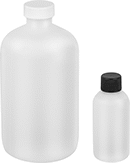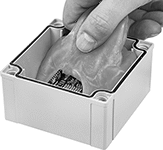About Paint and Protective Coatings
More
Optically Clear Two-Part Silicone Potting Compounds

Clear enough to read through, these UV-resistant potting compounds allow optimal light transmission for use with LEDs, solar cells, and fiber optics. Use them to encase electronic assemblies for protection from dust, moisture, mechanical shock, and vibration. Softer and more flexible than epoxies and urethanes with the widest temperature range, these silicone compounds are the best choice for high-temperature applications and electronics exposed to thermal cycling. They have excellent electrical insulation and good moisture resistance but poor chemical and abrasion resistance. Also known as RTV (room-temperature vulcanizing).
Gel compounds form a soft and flexible layer of protection. You can also remove them if you need to re-access your components. They are rated IP68 once potted, so they seal out water even if submersed.
Container | Dry Time | |||||||||||
|---|---|---|---|---|---|---|---|---|---|---|---|---|
| Size | Type | Consistency | Touch, min. | Overall, min. | Dielectric Strength, V/mil | Thermal Conductivity, W/m-K | Temp. Range, °F | Environmental Rating | For Use On | Color | Each | |
Compounds | ||||||||||||
| 10.1 fl. oz. | Bottle | Gel | 15 | 15 | 500 | 0.2 | -75° to 355° | IP68 | Aluminum, Brass, Bronze, Copper, Steel, Stainless Steel, Silver, Titanium, Plastic, Composites, Fiberglass | Clear | 00000000 | 000000 |
Reusable Silicone Potting Compounds



Make repairs or changes to electrical components after they’ve been potted. While most compounds are permanent, these form a gel that bonds to itself, so you can peel it off without damaging your equipment. Often used in junction boxes, they form a water- and dust-proof seal that’s rated IP68 while also providing excellent electrical insulation. Made of silicone, they withstand a wide range of temperatures and are soft and flexible enough to resist shock and vibration. However, they’re not as strong as permanent potting compounds, so they don’t resist scrapes as well as those made of epoxy and urethane. They’re also not as chemical resistant as epoxy and urethane compounds.
These compounds won’t solidify once you open the container, so you have time to make adjustments when applying them. When removing them from your components, they mostly come off in one piece but there might be some residue left over.
Bottle compounds are a better choice for filling up new enclosures than cartridge compounds because you can pour more in at a time. They have a compartment for each component and require mixing.
Cartridge compounds have a nozzle for precise application. The nozzle can also fit into junction box knockouts, so it’s easier to fill up installed enclosures than it is with bottle compounds. They come ready to use with no mixing required and no waiting time.
Dry Time | |||||||||||||
|---|---|---|---|---|---|---|---|---|---|---|---|---|---|
| Container Size, fl. oz. | Consistency | Touch, min. | Overall, min. | Mix Ratio | Dielectric Strength, V/mil | Thermal Conductivity, W/m-K | Temp. Range, °F | Environmental Rating | For Use On | Color | Clarity | Each | |
Bottle Compounds | |||||||||||||
| 8.4 | Gel | 15 | 15 | 1:1 | 500 | 0.2 | -75° to 390° | IP68 | Aluminum, Brass, Bronze, Copper, Steel, Stainless Steel, Titanium, Fiberglass, Ceramic, Glass, Composites, Plastic, Rubber | Blue | Semi Clear | 0000000 | 000000 |
| 33.8 | Gel | 15 | 15 | 1:1 | 500 | 0.2 | -75° to 390° | IP68 | Aluminum, Brass, Bronze, Copper, Steel, Stainless Steel, Titanium, Fiberglass, Ceramic, Glass, Composites, Plastic, Rubber | Blue | Semi Clear | 0000000 | 00000 |
Cartridge Compounds | |||||||||||||
| 9.4 | Gel | __ | __ | __ | 500 | 0.2 | -75° to 390° | IP68 | Aluminum, Brass, Bronze, Copper, Steel, Stainless Steel, Titanium, Fiberglass, Ceramic, Glass, Composites, Plastic, Rubber | Clear | Clear | 0000000 | 00000 |



























